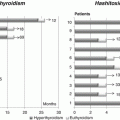Fig. 11.1
The figure displays the mean (full line), the -2 SDS and +2 SDS (dotted lines) L-T4 requirement in 216 CH patients diagnosed with neonatal screening from 6 months to 12 years of age (personal data). On the basis of body surface area (a) and body weight (b)
A proper initial and ongoing counselling of parents is very important to optimize the adherence to the replacement therapy, which has to be promoted throughout life. An optimal cognitive outcome depends on the adequacy and timing of postnatal therapy. Poor compliance to the treatment is the most common cause of persistent TSH elevation, accounting for the risk of major sequelae. These episodes are usually caused by poor parental compliance or impaired T4 bioavailability. In patients with episodes of insufficiently suppressed TSH after the age of 6 years, school delay in childhood and a subtle decrease in health-related quality of life in young adulthood may be detected.
11.3 Follow-up
Clinical examination, including assessment of growth and development, should be performed every few months during the first 3 years of life and then less frequently (see Table 11.1). Infants with CH appear to be at increased risk of other congenital anomalies (approximately 10 % of infants with CH). Cardiovascular anomalies (i.e. pulmonary stenosis, atrial septal defect, ventricular septal defect) are the most common [9]. Serum T4/fT4 and TSH measurements should be performed as reported in the table. It is recommended to perform the thyroid function tests more frequently when the adherence to the treatment appears low and abnormal values occur. When the daily dose is changed, fT4 and TSH measurements should be repeated by 4–6 weeks.
Table 11.1
Summary of the suggestion during the follow up
Biochemical and auxological assessment | 1. 2 and 4 weeks after the initiation of L-T4; 2. Every 1–2 months during the first 6 months; 3. Every 3–4 months between 6 months and 3 years; 4. Every 6–12 months until growth is completed. |
L-T4 change because of abnormal values | Check hormones values after 4–6 weeks |
Re-evaluation of the thyroid axis | After the age of 3 years in selected patients |
Neurodevelopmental outcome | To be monitored at each visit; keep attention to patients with severe CH at diagnosis |
Hearing test | Before school age |
Visual development | If clinically indicated |
Speech evaluation | By 3 years of age |
Genetic counselling | Suggested in case of recurrence of CH and extra-thyroidal diseases (heart, palate, pituitary, kidney etc malformation). |
The aim of therapy is to ensure normal growth and development by maintaining the serum total T4/fT4 concentration in the upper half and serum TSH in the lower half of the reference range.
In the first months of life, serum TSH may be above the normal values despite T4/fT4 concentrations in the reference range. Excessive dose of L-T4 may cause hyperthyroidism with adverse effects, such as tachycardia, shortening of sleeping and overall premature craniosynostosis.
In patients properly treated, growth, puberty and fertility are normal [10–12]. There are only minor differences in IQ score, school achievement and neuropsychological tests in patients with CH as compared to control groups of classmates and siblings [13–17]. These defects may be more evident in patients with severe CH at diagnosis. Other defects may be impaired visuospatial processing and selective memory and sensorimotor defects. It is still debated whether these minor differences are preventable by further optimizing postnatal therapy. The prognosis of developmental outcome is worsened in patients with delayed diagnosis and treatment.
Stay updated, free articles. Join our Telegram channel

Full access? Get Clinical Tree





